|

GLAMIS CASTLE is widely
known as one of the most interesting buildings, both historically and
architecturally, in Scotland. To the lover of Shakespeare, the name of
Glammiss (as it was sometimes spelt) will recall the act of treachery
and murder which tradition gives as having taken place there, when King
Duncan was done to death by the hand or at the instigation of the
ambitious and unscrupulous Lady Macbeth ; although there is no
possibility of proving or testing the truth as to the details or
locality of the tragedy.
To the antiquarian the Castle must be of immense interest, on account of
the great age of the central portion or Keep, which is known to have
been standing in 1016, but "whose birth tradition notes not " ; while to
the romantic and superstitious it is a place where ghosts and spirits
moving silently down winding stairs and dark passages are wont to make
night fearsome. This feeling of eeriness is not confined to the
naturally nervous, for Sir Walter Scott, who spent a night at Glamis in
1704, writes :
" After a very hospitable reception, I was conducted to my apartment in
a distant part of the building. I must own that when I heard door after
door shut, after my conductor had retired, I began to consider myself
too far from the living and somewhat too near the dead."
Additional interest attaches to this Castle from the fact that its
venerable walls enshroud a mysterious something, which has for centuries
baffled the curiosity and investigations of all unauthorised persons :
this secret is known only to three people —the Earl of the time being,
his eldest son, and one other individual whom they think worthy of their
confidence.
Most people have theories upon this subject, and many ridiculous stories
are told ; but so carefully has the mystery been guarded, that no
suspicion of the truth has ever come to light.

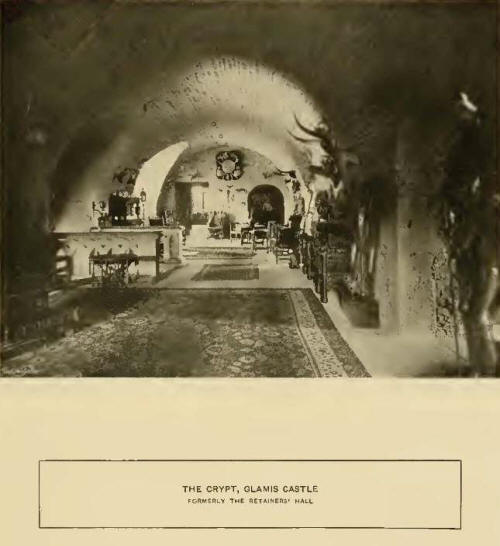
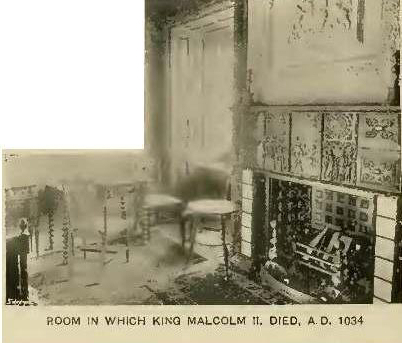
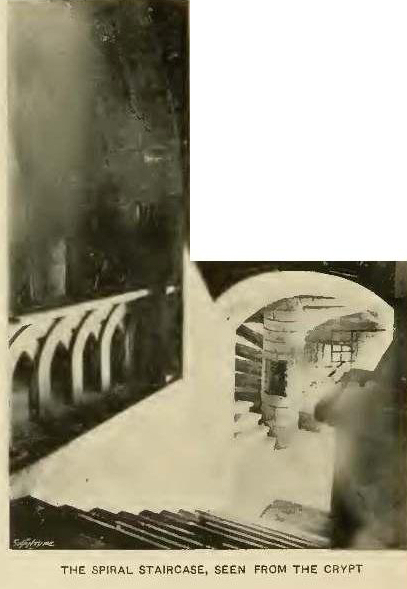
One version of the story
is as follows : Several centuries ago Lord Glamis of the time was
entertaining the head of another noble family then resident in Angus;
and in the course of the evening they commenced to play cards. It was
Saturday night, and so intent were they on wagering lands and money on
the issue of the game, that they did not recognise the fact that Sunday
morning was approaching until an old retainer ventured to remind them of
the hour. Whereupon one of the gamblers swore a great oath, with the
tacit approval of the other, that they did not care what day it might
be, but they would finish their game at any cost, even if they went on
playing till Doomsday ! It had struck midnight ere he had finished his
sentence, when there suddenly appeared a stranger dressed in black, who
politely informed their lordships that he would take them at their word
and then vanished. The story goes on to aver that annually on that night
these noblemen, or their spirits meet and play cards in the secret room
of the Castle, and that this will go on till Doomsday. In corroboration
of this story, it is said that on a certain night in the autumn of every
year loud noises are heard and some of the casements of the Castle are
blown open.


Glamis Castle stands in
the centre of the vale of Strathmore, in a picturesque and well-wooded
part of Forfarshire ; the heather-clad sides of the Sidlaws, which
divide Strathmore from the sea, rising to the south, while away to the
north tower the Grampians, which form a magnificent background to the
ancient pile of buildings whose turrets rise some hundred and fifteen
feet above the level of the ground.
The poet Gray, in a letter, describes the exterior of the Castle in the
following words:
"The house, from the
height of it, the greatness of its mass, the many towers atop, and the
spread of its wings, has really a very singular and striking appearance,
like nothing I ever saw."
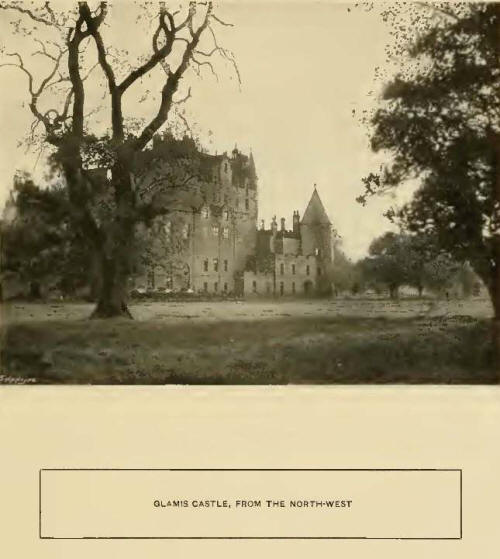
The oldest portions of
the Castle are formed of huge irregular blocks of old red sandstone,
which time and weather have mellowed into a beautiful grey-pink colour.
The original Keep was evidently about three or four storeys high, but
Earl Patrick in 1670 heightened it considerably; the extra storeys were,
however, so well " clappit on" (to use the Earl's own words) that it is
impossible to see where the additions commence. The walls of the Castle
in many places are sixteen feet thick, which in the olden days had the
essential recommendation of great security, and also of allowing space
for secret rooms and passages as means of escape in times of peril ;
and, as a matter of fact, two secret staircases have been discovered
within the last five-and-twenty years, and possibly there are others,
which still remain forgotten and unused.
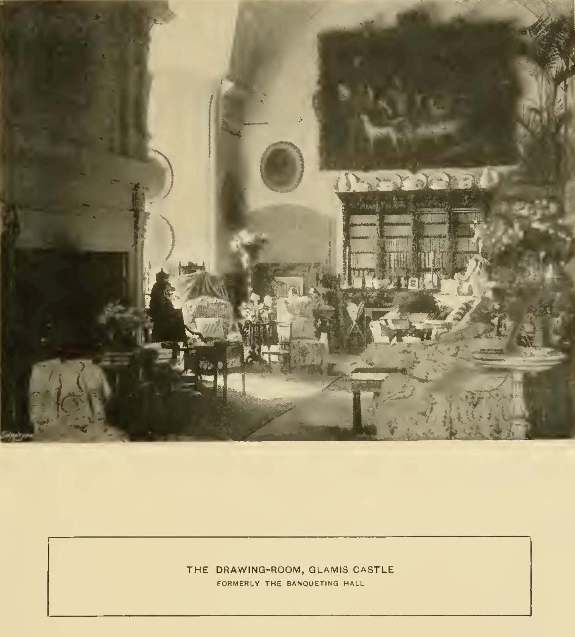
The narrow windows appear
at irregular heights and distances in the central building or Keep and
left wing (the right wing having been burnt down and rebuilt early in
1800 is not so interesting), but the great staircase added by Patrick,
Lord Glamis, in 1605 is very fine, occupying a circular tower, the space
for which has been partly dug out of the old walls of the Keep, and
rises to the third storey. This staircase (the designing of which has
been attributed to Inigo Jones) is spiral with a hollow newel in the
centre, and is composed of stone to the summit. It consists of 141
steps, 6 ft. 10 in. in width, each of one stone.
The staircases which were in use before 1600 are very narrow, dark, and
some of them winding, the steps steep and irregular in height, worn into
hollows by the many feet that for centuries climbed them. Up two flights
of these dimly lit, uneven stairs, the wounded king, Malcolm II., after
having been treacherously attacked and mortally wounded by Kenneth V.
and his adherents on the Hunter's Hill, about a mile from the Castle,
was carried by his followers to die in the chamber that still bears the
name of King Malcolm's Room. This murder of King Malcolm is the first
authentic event mentioned by the chroniclers in connection with Glamis.
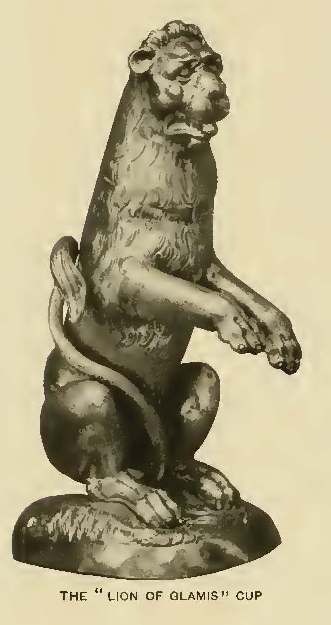
In the parish of Glamis
stand three huge stones of rude design, covered with symbolic
sculptures, which according to tradition were erected to commemorate the
death of Malcolm II. One on the Hunter's Hill is supposed to mark the
spot where he fell, and stands about seven feet high, facing the east; a
cross, figures of men, and various symbols are sculptured on it, but are
much defaced. The stone close to the kirkyard is much larger, and is
called King Malcolm's gravestone, although that king was not buried
there. An ornamental cross and many curious symbols are carved on the
side facing the east; on the other side a fish, a serpent, and a circle
are seen, —symbols of Christianity,— which carvings are of a later date
than the cross, etc., and are attributed to the Knights Templars, who
lived in that part of Scotkind for a long time.
In the time of King Malcolm, Glamis was a royal residence, and remained
so till 1372, when Sir John Lyon, "a young man of very good parts and
qualities, and of a very graceful and comely person, and a great
favourite with the king" (Robert II.), was made Lord High Chamberlain of
Scotland. At that time the King's daughter, the Princess Jean, fell in
love with this young knight, and was given him in marriage, together
with the lands of the thanedom of Glamis, "pro laudabili et fideli
servitio et continuis laboribus," as the charter bears witness, March
18, 1372. Ten years later Sir John fell in a duel with Sir James Lindsay
of Crawford, and was buried at Scone among the kings of Scotland. He
left one son, from whom the present family of Lyon have descended
without a break from father to son to the present day. (It may be
mentioned incidentally that the ancestor of the Lyon family came over
with William I., and that either he or one of his immediate descendants
settled in Perthshire in the district still called Glenlyon.)

Fifty years later, Sir
Patrick Lyon (Sir John's grandson), who was one of the hostages to the
English for the ransom of James 1. from 1424 to 1427, was created Baron
Glamis, and appointed Master of the Household to the King of Scotland.
For the next hundred years nothing of interest occurred, till John,
sixth Lord Glamis, married the beautiful Janet Douglas, granddaughter of
the great Earl of Angus (" Bell-the-Cat "), and died in 1528. Lady
Glamis married, secondly, Archibald Campbell, of Kepneith, whose
relative, another Campbell, fell in love with her. Finding, however,
that his addresses were but ill received by this lady, who was as good
as she was lovely, his love turned to hate, and he revenged himself by
informing the authorities that Lady Glamis, her son Lord Glamis, and
John Lyon, his relative, were conspiring against the life of the king,
James V., by poison or witchcraft. They were tried for high treason, and
wrongfully convicted ! Lady Glamis and her young son were both sentenced
to be burned, and the estate of Glamis was forfeited and annexed to the
Crown by Act of Parliament, December 3, 1540. However, these brutal
judges, on account of the extreme youth of Lord Glamis, feared to bring
him to execution, so the boy was kept in prison, with the death sentence
hanging over him, while the beautiful Lady Glamis was dragged forth and
burned at the stake on the Castle Hill of Edinburgh, July 17, 1537.
Those were days when acts of violence and cruelty were regarded with an
indifference that we cannot now realise, although when she stood up in
her beauty to undergo this fearful sentence, it is recorded that all
heads were bowed in sorrowful sympathy. When this infamous execution was
accomplished, remorse seems to have come over Campbell, who was visited
by visions of his victim looking at him with sad, reproachful eyes.
When, some years later, his death was drawing nigh, he confessed that
his evidence at the trial was altogether false. Lord Glamis was
therefore released from prison, and his estates and honours restored.
To return to the Castle. The exterior is much ornamented with ancient
armorial bearings in carved stone of the principal Earls since 1606,
quartered with those of their separate wives, among them the Murray,
Panmure, Ogilvey, and Middleton quarterings. Above one window the
initials of Patrick, first Earl of Kinghorne, and of Dame Anna Murray,
his wife, daughter of the first Earl of Tullibardine, are placed, while
a round niche over the front door contains a bust of Earl Patrick, of
whom mention will be made presently. The principal entrance is a
striking feature. The doorway is small and low, and a stout,
iron-clinched oaken door, thickly studded with nails, is guarded on the
inside by a heavily grated iron gate, which opens right on to the great
staircase. A flight of steps to the right of the entrance leads down to
the dungeons, vaults, and the old well (now filled up) which supplied
the inmates with water in times of siege ; while another stair to the
left leads up to the Retainers' Hall (or Crypt as it is now called),
low, and fifty feet in length, with walls and arched roof entirely
composed of stone. Of the seven windows, which are small, four or five
are cut out of the thickness of the walls, and make recesses just large
enough to form small rooms, which might have been used as
sleeping-chambers in old days. Lay figures, clad in complete armour,
stand in the recesses, which, especially in the dusk, give an eerie
effect to this part of the Castle. It is said that a ghostly man in
armour walks this floor at night—possibly the original of one of those
armoured figures standing silently in the Crypt year after year, who
may, perchance, have ended his life in the dungeon that lies exactly
underneath. A square stone, now practically immovable, formed the
covering of the hole by which prisoners were lowered into the dungeon
beneath. But there is no doubt that there was also a stair connecting
the hall with the dungeon, which, along with the other old staircases
(some of them have recently been opened out), was walled up at the time
the great new central staircase was built.
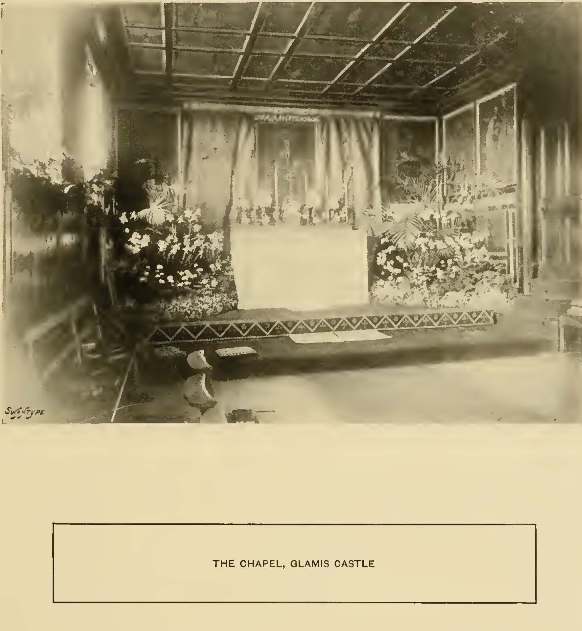
From the south-east
corner of the Crypt a short, dark passage, cut through the stone walls,
leads to the small, quaint, and irregular Duncan's Hall, the traditional
scene of Macbeth's crime, where a year or so ago an old hearth was
discovered built up in the masonry, and has been opened out. The
Dining-room, which is entered from the west end of the Crypt, is another
fine room, though quite modern, having been rebuilt early in 1800. The
walls are panelled in oak, and adorned with some good family pictures ;
but the most interesting object that occasionally appears in it is the
old silver-gilt drinking-cup in the form of a lion, a very ancient piece
of plate, holding about a pint of wine, which in old days each guest was
expected to drain before quitting the Castle. Sir Walter Scott was one
of those who swallowed the contents of the lion, and in a note to
Waverley he says, ''the feat served to suggest the story of the Bear of
Bradwardine."


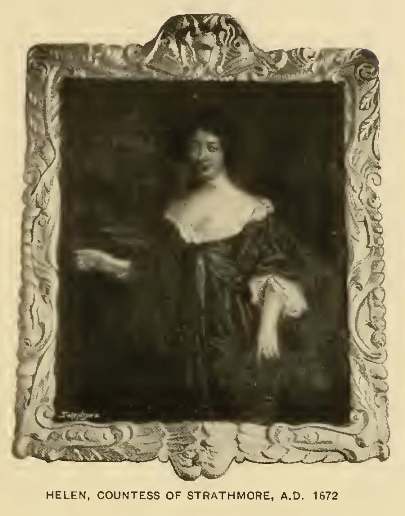
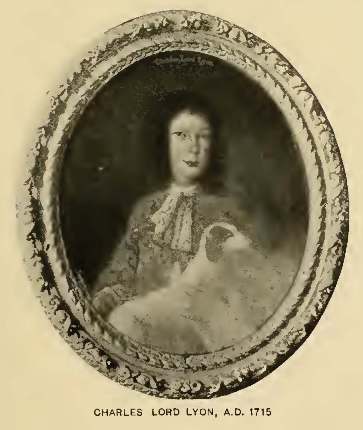
Leaving this floor, with
its dark winding passages, its grated, prison-like windows, and
ascending a side staircase, King Malcolm's room is passed, and the
Banqueting Hall (now used as the Drawing-room) is entered. This room is
a fine specimen of the old baronial days, being sixty feet long by
twenty-two wide, with a coved ceiling of beautifully designed
plaster-work, which was added to the room by Earl John in 1621, whose
initials, with those of his wife, together with the date, are placed at
intervals among the patterns of the mouldings.
The chimneypiece of carved stone is very fine, reaching to the top of
the room, while pictures of the Lyon family, as well as of some of the
Stuart kings and other notables, adorn the walls. Here hangs the
portrait by Sir Peter Lely of the celebrated John Graham of Claverhouse,
Viscount Dundee ; this well-known and distinguished chief, who, had he
lived longer, would probably have restored Scotland to King James II.,
was a great friend of the Lord Strathmore of the time, and consequently
spent many days at Glamis, Claverhouse being situated a bout twelve
miles to the south. The picture represents Dundee as a very handsome
young man, with features soft and refined even to feminine regularity;
but under this gentle exterior can be detected the undaunted and
enterprising valour coupled with the prudence and determination that
were the acknowledged attributes of his character. His coat, a sad
buff-coloured felt, laced with silver, and evidently similar to the one
he was wearing when he met his death at Killiecrankie, is kept as a
valuable relic in the Castle.
What different scenes must this, old Hall have witnessed in its time !
Not many years prior to the visits of the gallant Clavers, the soldiers
of the Commonwealth held their rude orgies under its roof, having been
quartered at Glamis by Cromwell's orders as a piece of petty revenge,
because John, second Earl of Kinghorne, had voted against the delivery
of King Charles 1. To the Parliament. Then in 1715 deep mourning surely
reigned there, when the news arrived that the brave and promising young
Earl of Strathmore had been killed at the battle of Sheriffmuir, after
fighting hard and gallantly in the cause of the Stuarts.
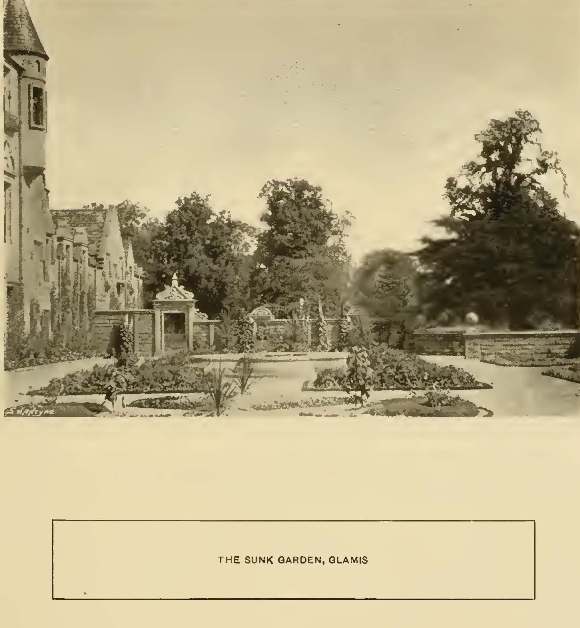
The following year the
mourning was turned to joy when Prince James spent two nights at Glamis
on his way to Scone. What feasting and loyal toasts must have been given
in the Hall in the course of those two snowy nights and days, when the
Chevalier received many of his followers, and gained all hearts by his
princely qualities ! It is said that during this visit eighty-eight beds
were made up in the Castle for the gentlemen in his train. The
Chevalier's bed is still to be seen, though much spoiled by tourists,
who, on certain days, are allowed to go over the Castle ; and the room
he occupied, with a secret stair concealed in the walls, still bears his
name. His watch and sword are among the treasured curiosities in the
Castle, the former having been found under his pillow after he left for
Dundee. The sword bears the following inscription:
"God save King James 8th:
prosperitie to Scotland and no union. "
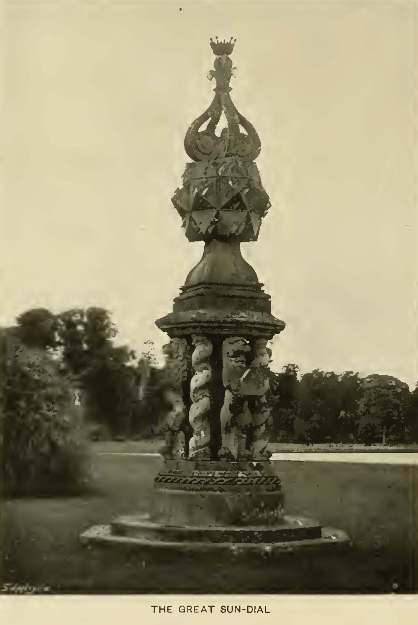
But to return to the Hall
itself. The principal picture hangs at the end of the room, and
represents Patrick, first Earl of Strathmore and third of Kinghorne, who
beautified Glamis considerably both within and without, as his diary
testifies, which is in perfect preservation, and well illustrates the
social life of Scotland more than two hundred years ago. In this
portrait he is depicted sitting with three of his sons, pointing with
pride to the Castle in the distance, on which he had spent so much care.
At that time the Castle was surrounded by walled courts, gardens, and a
moat; and the main approach to the south, about a mile in length, was
guarded by seven gates, and was the work of Earl Patrick. These
surroundings were all pulled down early in 1800 by a disciple of
"Capability Brown," the two flanking towers alone being left!
Sir Walter Scott, who revisited Glamis after this barbarous act of
modernising had been accomplished, describes the changes in such
beautiful language that it should be quoted:
"Down went many a trophy
of old magnificence, courtyard, ornamented enclosure, fosse, avenue,
barbican, and every external muniment of battled wall and flanking
tower, out of the midst of which the ancient dome, rising high above all
its characteristic accompaniments, and seemingly girt round by its
appropriate defences, which again circled each other in their different
gradations, looked, as it should, the queen and mistress of the
surrounding country. It was thus that the huge old Tower of Glamis once
showed its lordly head above seven circles of defensive boundaries,
through which the friendly guest was admitted, and at each of which a
suspicious person was unquestionably put to his answer."
There were two or three moats surrounding the Castle, but the)' were
tilled in by Patrick, third Earl of Kinghorne and first Earl of
Strathmore. That Earl proceeds to say of these moats, in his diary,
"which stankt up the water so that the place appeared marish and weat,"
and was generally condemned as "an unholsom seat of a house."
Very close to the walls of the Castle there are the remains of what some
consider to have been a moat, whilst others consider it to have been an
underground passage. It appears hardly wide enough for a moat, and the
fact of the sides being lined and the top beautifully arched with stone
almost favours the supposition that it may be part of that underground
passage of which there has long been a tradition.
The Chapel, which opens out of the Drawing-room, is one of the most
interesting parts of the Castle. Thirty feet by twenty ; walls and
ceiling are divided into thirty-four panels, each one containing a
picture relating to the life of our Lord and the Twelve Apostles. These
paintings were executed by a Dutch artist named De Witt, whom Earl
Patrick engaged by contract, in 1688, to paint all the Chapel (as well
as a good many ceilings and portraits) for the sum of £90. The contract
for this work is still among the family papers, and is very curious, as
De Witt was evidently a slippery fellow who required a good deal of
binding. When the present Lord Strathmore succeeded to the title in 1800
he found the paintings in perfect preservation, but the Chapel in a
sadly neglected state ; he therefore had it beautifully restored and
rededicated, and daily service has been held there ever since ; the
painted walls and ceiling, stained glass, beautiful embroidered
altar-cloths (worked by the present Lady Strathmore), and flowers,
render this little chapel peculiarly attractive as a place of worship.
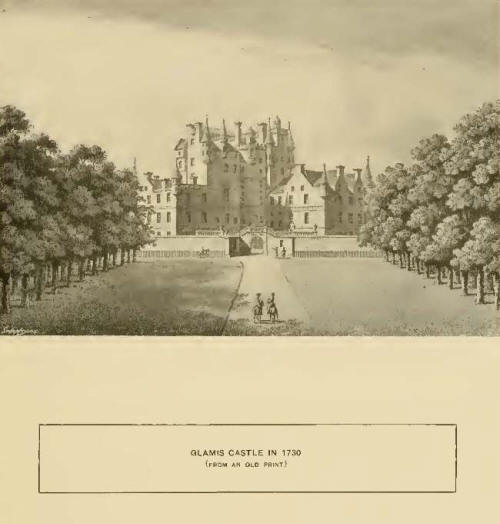
The Billiard-room, with
its fine and valuable tapestry, representing incidents in the life of
Nebuchadnezzar, and of which only three examples were known to exist, is
on this same floor, and is the last of the large rooms, being fifty feet
long, but it is not part of the ancient building. Here stands a great
chest filled with beautiful costumes in flowered silks, velvets, and
satins, as well as old uniforms, all belonging to Lyon ancestors of
several centuries ago; besides these a fool's dress remains, cap, bells,
and all complete—a rare possession nowadays. Sometimes these ancient
garments see the light, when the Castle is full of young and merry
guests, who don these slashed and broidered coats and skirts, and when
gathered together in the old Crypt almost seem to have forced back the
hands of the clock of time two or three hundred years.
There remains yet much to tell, but space fails. The old kitchen, an
underground vault, dark and low, with one loophole to light it, is a
contrast to the present kitchen, which is fifty feet long and broad in
proportion. The great sun-dial on the lawn is quite unique, bearing as
it does eighty-four dials, supported by four nearly life-size lions in
stone; and although the exact age of this remarkable piece of work is
not known, old pictures of Glamis prove that it was standing in front of
the Castle in 1600. A balustrade of fine seventeenth-century iron work
runs round the top of the Castle, from whence, on clear days,
magnificent views may be obtained of the surrounding country; while the
beautiful gardens, walks, and drives, which have been created by the
present Lord Strathmore (who has bestowed as much care on the old place
as his ancestor, Earl Patrick, of whom mention has been made), deserve
more than passing notice. The old Castle, as it now is, enlivened by the
cheerful surroundings of a large family party, and ringing with the glad
sounds of grandchildren's voices, is a truly pleasant place to live in;
whilst the great iron gate stands hospitably open to welcome the many
guests who pass that way, who, in spite of the Castle's reputation for
ghosts, seem to pass their time merrily enough.
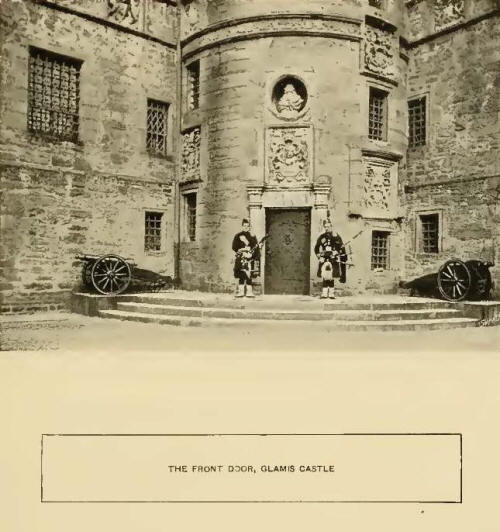 |
